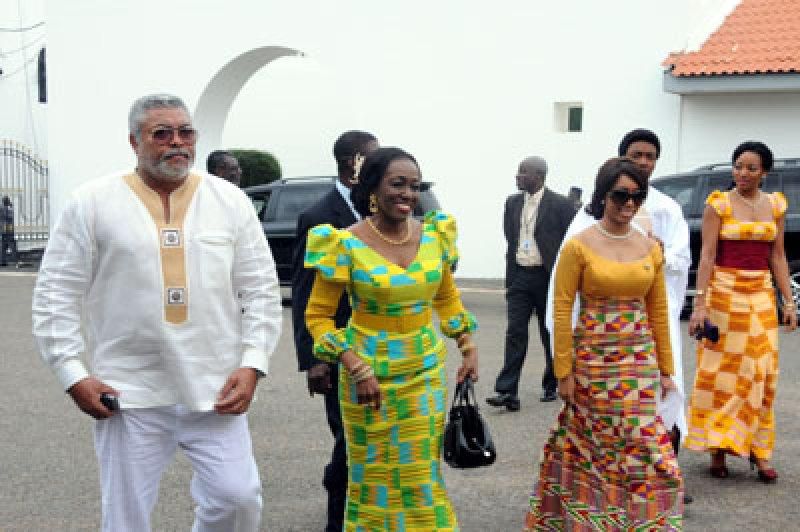5 times Nana Konadu Agyeman-Rawlings inspired fashion in Ghana
)
Ghana’s former First Lady and a leading advocate for women’s rights, Nana Konadu Agyeman-Rawlings, has passed away at the age of 77. She died in the early hours of Thursday, 23 October 2025, at the Ridge Hospital in Accra.
Born on 17 November 1948 in Cape Coast, Nana Konadu Agyeman-Rawlings was a towering figure in Ghanaian politics and a lifelong advocate for women’s empowerment. As the wife of the late former President Jerry John Rawlings, she served as Ghana’s First Lady first in 1979 and later from 1981 to 2001, during which she transformed the traditionally ceremonial role into a platform for social and political advocacy.
Nana Konadu Agyeman-Rawlings, Ghana’s former First Lady, is more than a political matriarch, she is a timeless fashion icon whose style continues to influence generations. Known for her poise, elegance, and unapologetic embrace of African aesthetics, Nana Konadu redefined what it meant to be both powerful and fashionable in Ghana.
From her distinctive head wraps to her mastery of Ghanaian textiles, she consistently used fashion as a language of identity, confidence, and cultural pride.
Here are five defining moments when Nana Konadu Agyeman-Rawlings inspired the nation’s sense of style and left an enduring mark on Ghana’s fashion landscape.
1. The Kente Power Look
In the early 1990s, during several international visits with her husband, the late President Jerry John Rawlings, Nana Konadu often appeared in regal kente ensembles that captivated both local and foreign audiences.
Rather than adopting Western suits common among First Ladies of her time, she proudly chose kente, Ghana’s royal fabric, styled into sophisticated gowns with bold headwraps. Her look was always completed with gold accessories that embodied strength and elegance.
She elevated kente beyond ceremonial wear, proving it could symbolise diplomacy, prestige, and modern femininity. Ghanaian women began incorporating kente into weddings, graduations, and official events, following her example of wearing heritage with pride.

2.The Headwrap Revolution
Nana Konadu’s signature headwrap, often towering, intricately tied, and colour-coordinated with her outfit, became a national fashion statement throughout the 1980s and 1990s.
Her duku styles were more than accessories; they were statements of self-respect and authority. Each fold carried precision, and her bold colour combinations often reflected her spirited personality.
Ghanaian women began embracing headwraps not merely as practical hair covers, but as artistic expressions of identity. Tailors and stylists began designing outfits around headwraps, and fabric sellers saw a surge in demand for brighter prints. Nana Konadu made the duku a symbol of elegance and confidence for the modern Ghanaian woman.
)
3. The African Print Movement
Throughout her tenure as First Lady, Nana Konadu was one of the earliest advocates for promoting Ghanaian-made fabrics. She wore GTP, ATL, and locally handwoven textiles long before “wear Ghana” became a movement.
Her wardrobe was a showcase of creativity, combining Ankara and wax prints in structured blouses, pencil skirts, and flowing dresses that reflected both modern taste and cultural authenticity.
READ MORE: Shatta Wale to make ShattaFest an annual music festival after record-breaking 2025 edition
She encouraged women to support local designers and wear made-in-Ghana fashion with pride. Her commitment to local textiles laid the foundation for today’s Wear Ghana campaign, inspiring new generations of designers such as Christie Brown, Duaba Serwa, and Pistis to celebrate African identity through fashion.
)
4. The Feminine Power Suit:
In an era when women in leadership were expected to dress conservatively, Nana Konadu fused elegance with authority through her tailored African-inspired suits.
Her ensembles often featured structured jackets with traditional fabric trims, styled with pencil skirts or kaba-inspired blouses. She used soft fabrics in strong silhouettes, a visual metaphor for strength wrapped in grace.
Her approach inspired professional women to embrace fashion without compromising professionalism. By redefining office wear with an African touch, she empowered women to take up leadership roles while maintaining their femininity and cultural identity.
)
)
5. The Legacy Look
Even after leaving public office, Nana Konadu continues to embody sophistication at every public appearance—from national ceremonies to party functions.
Her current style merges mature elegance with consistency. She remains loyal to African prints, gold jewellery, and coordinated ensembles that exude grace and dignity.
Younger women look to her as a fashion matriarch—proof that style has no age limit. Her influence continues to inspire designers to create pieces that celebrate Ghanaian heritage through timeless design.
)
)
)
)
)
)
)
)